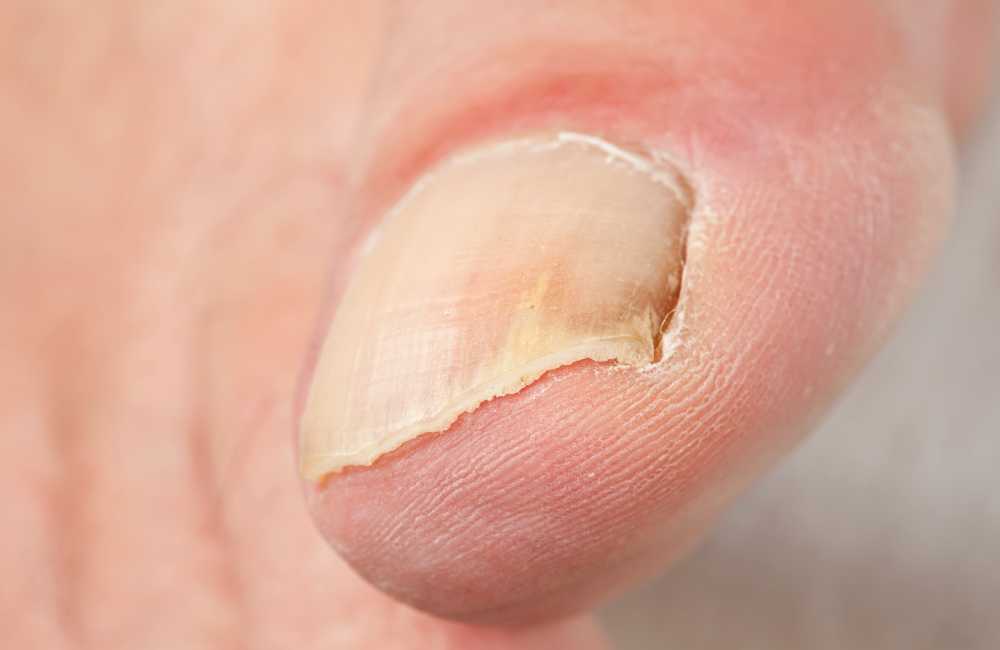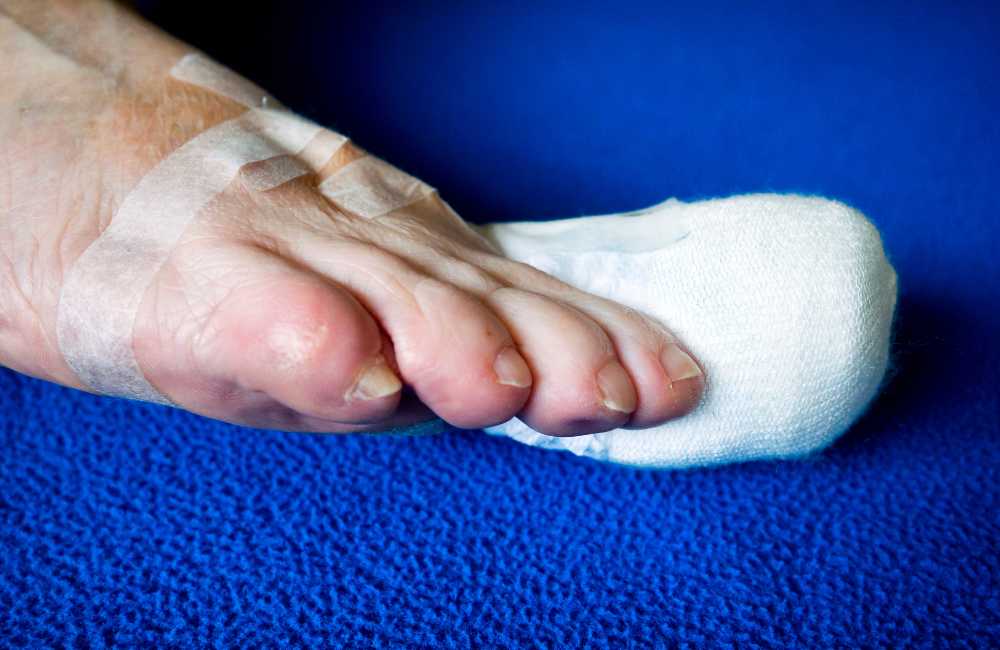Ingrown toenails, also known as onychocryptosis (Hidden nail) or unguis incarnates is a common nail disease. It is a very painful condition that results when either the nail grows in such a way that the corner or side of a toenail grows into the soft flesh or the toe skin overgrows.
This condition can occur in the nails of both the hands and the feet but they occur most commonly in the toenails. The result is pain, inflamed skin, swelling and, sometimes, an infection.
Classification of ingrown toenail
This is based on the severity and thus three stages of severity are of importance:
Stage 1
The nail has grown into the skin on the side. The skin hurts and has become inflamed.
Stage 2
New, inflamed tissue (granuloma) has grown at the edges of the ingrown toenail. The tissue is weeping and producing pus.
Stage 3
The skin around the toenail is chronically inflamed and keeps oozing pus. The granuloma has already started growing over the nail.
Causes of ingrown nail

- Cutting toenails incorrectly (Cut straight across, since angling the sides of the nail can encourage the nail to grow into the skin).
- Irregular, curved toenails.
- Tight-fitting footwear places a lot of pressure on the skin around the toenail. Such foot wares as socks and stockings that are too tight or shoes that are too tight, narrow, or flat for your feet.
- Toenail injury, including stubbing your toe, dropping something heavy on your foot, or kicking a ball repeatedly.
- Sweaty feet – if the skin around your toenails is soft, it’s easier for your nail to pierce it and embed itself within it.
- Poor posture.
- Improper foot hygiene, such as not keeping your feet clean or dry.
- Genetic predisposition.
- Congenital (foot shape) — for instance, if your nail is larger comparatively with your toe, or the surrounding tissue of the nail border naturally grows around your nail.
- Using your feet extensively during athletic activities can make you especially prone to getting ingrown toenails. Activities in which you repeatedly kick an object or put pressure on your feet for long periods can cause toenail damage and increase your risk of ingrown toenails. These activities include:
-
- Ballet.
- Football.
- Kickboxing.
- Soccer.
Symptoms of ingrown toenail
Initial or Early-stage symptoms include:
- The skin next to the nail becomes tender, swollen, or hard.
- Pain when pressure is placed on the toe.
- Fluid building up around the toe.
If the toe becomes infected, symptoms may include:
- Red, swollen skin.
- Pain.
- Bleeding.
- Oozing pus.
- Overgrowth of skin around the toe.
Investigations
-
X-ray
In young patients (e.g., less than 20 years) with recurrent ingrown toenails, x-rays should be considered to exclude underlying osteochondroma.
-
Biopsy
In the absence of an ingrown toenail, apparent granulation tissue around the toe suggests the possibility of amelanotic melanoma, which is often overlooked.
Diagnosing ingrown toenail
Diagnosis is by clinical evaluation. An ingrown toenail can be diagnosed without any complex examinations. Doctors take a close look at the affected toe and ask about the symptoms and any possible causes.
Treatment for ingrown toenail

-
Non-surgical
-
- Soaking the affected foot in warm water for about 15 to 20 minutes three to four times per day (At other times, your shoes and feet should be kept dry.)
- Pushing skin away from the toenail edge with a cotton ball soaked in olive oil.
- Using over-the-counter medicines, like acetaminophen for the pain.
- Applying a topical antibiotic, such as polymyxin and neomycin (both present in Neosporin) or a steroid cream, to prevent infection.
- The use of nail bracing is more conservative than surgery, but less widely used. Nail braces work by gently lifting the sides of the toenail and eventually retraining the nail to grow a flatter shape over time. There are two main types of nail braces:
-
-
- Adhesive
-
Adhesive nail braces are generally made of a thin strip of composite material that is glued to the top of the nail. The strip naturally tries to return to a flat state and lifts the edges of the nails in the process.
-
-
- Hooked
-
Hooked nail braces consist of a hook (usually made of dental wire) placed under either side of the nail with some type of tensioning system pulling the hooks together.
-
Surgical
-
- Partial nail removal (wedge resection)
During a partial nail removal, the sides of the nail are cut away so that the edges are completely straight. A piece of cotton is placed under the remaining portion of the nail to keep the ingrown toenail from recurring. The doctor may also treat your toe with a compound called phenol, which keeps the nail from growing back.
The healing time for this procedure is 4 -6 weeks.
-
- Total nail removal
May be used if your ingrown nail is caused by thickening. In this case, the entire nail is removed. This procedure is called a matrixectomy. The healing time for this procedure is 6 -8 weeks.
How to prevent an ingrown toenail
To help prevent an ingrown toenail:
- Trim your toenails straight across.
- Don’t curve your nails to match the shape of the front of your toe. If you get a pedicure, ask the person doing it to trim your nails straight across. If you have a condition that causes poor blood flow to the feet and you can’t trim your nails, see a podiatrist regularly to have your nails trimmed.
- Keep toenails at a moderate length.
- Trim toenails so they’re even with the tips of your toes. If you trim your toenails too short, the pressure from your shoes on your toes may direct a nail to grow into the tissue.
- Wear shoes that fit properly.
- Shoes that place too much pressure on your toes or pinch them may cause a nail to grow into the surrounding tissue. If you have nerve damage to the feet, you may not be able to sense if your shoes fit too tightly.
- Wear protective footwear.
- If your activities put you at risk of injuring your toes, wear protective footwear, such as steel-toed shoes.
- Check your feet.
- If you have diabetes, check your feet daily for signs of ingrown toenails or other foot problems.
Complications that can develop include:
-
- Bone infection
- Foot ulcers
- Gangrene (decaying tissue). This is rare.
- Losing a limb
Conclusion
An ingrown toenail is a common, often unpleasant condition frequently seen in the big toenail that can cause pain and swell especially for people who wear shoes that are too tight or don’t allow their feet to breathe and this can be prevented by maintaining hygiene and dryness on the feet.
It is not unusual for an ingrown toenail to recur unless treated appropriately so If you have a badly ingrown toenail do not treat yourself but see a foot specialist (podiatrist).

